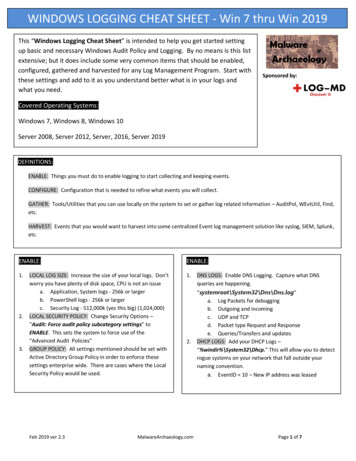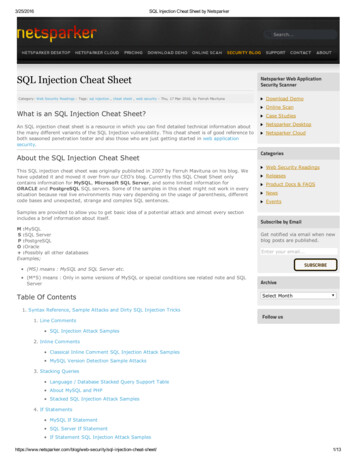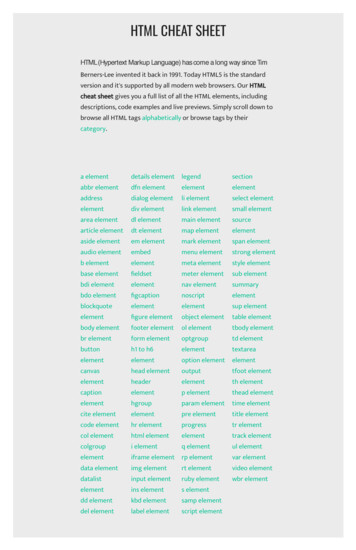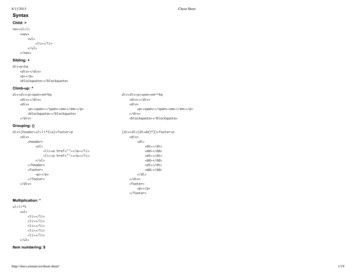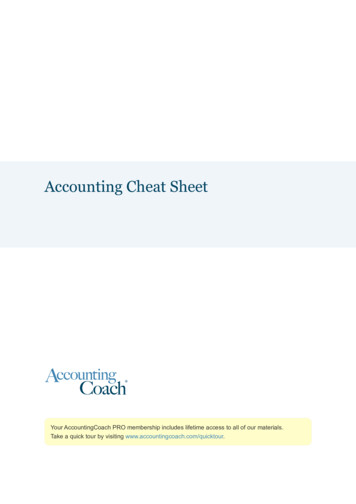
Transcription
Accounting Cheat SheetYour AccountingCoach PRO membership includes lifetime access to all of our materials.Take a quick tour by visiting www.accountingcoach.com/quicktour.
Table of Contents (click to navigate)Financial Statements3Balance Sheet4Income Statement5Cash Flow Statement6Stockholders’ Equity7Financial Ratios8Accounting Principles9Bookkeeping, Debits & Credits10Accounting Equation11Adjusting Entries12Bank Reconciliation13Petty Cash14Accounts Receivable & Bad Debts Expense15Inventory & Cost of Goods Sold16Depreciation17Accounts Payable18Cost Behavior & Break-even Point19Payroll Accounting20Standard Costing21Accounting ’s Accounting Cheat Sheet is a quick reference and overview of accountingconcepts. You should consult a professional accountant and/or the accounting profession’s officialpronouncements for specific situations and for more complete information.For personal use by the original purchaser only. Copyright AccountingCoach .com.2
Financial StatementsFinancial statements are general purpose, external financial statements prepared according togenerally accepted accounting principles. Some terms that apply to the financial statements include:balance sheet reports the amounts of assets, liabilities, and stockholders’ equity at a specifiedmoment, such as midnight of December 31; also known as the statement of financial position.income statement reports revenues, expenses, gains, losses, and net income during the period oftime stated in its heading; also known as the statement of operations and as the profit and loss (P&L)statement.statement of cash flows reports the changes in cash and cash equivalents during a period of timeaccording to three activities: operating, investing, and financing.statement of stockholders’ equity reports the changes in the components of stockholders’ equity,including net income, other comprehensive income, dividends, exercise of stock options.interim financial statements issued between the annual financial statements, e.g. quarterly.audited financial statements independent CPA firm gives assurance about reasonableness andcompliance with accounting principles.financial reporting includes financial statements, annual and quarterly reports to SEC andstockholders, press releases and other financial reports.Note: To learn more about Financial Statements see our Video Seminar, Visual Tutorial and ExamQuestions in AccountingCoach Pro.For personal use by the original purchaser only. Copyright AccountingCoach .com.3
Balance SheetThe balance sheet or statement of financial position reports assets, liabilities, owner’s orstockholders’ equity at a point in time. Some terms that apply to balance sheets include:assets resources, things owned, and prepaid or deferred expenses; examples include cash,accounts receivable, inventory, prepaid insurance, land, equipment, vehicles, furnishings.liabilities obligations and deferred revenues; examples include accounts payable, loans payable,wages payable, interest payable, customer deposits, deferred revenues.owner’s equity a sole proprietorship’s assets minus its liabilities.stockholders’ equity a corporation’s assets minus its liabilities; reports paid-in capital, retainedearnings, and treasury stock.accounting equation Assets Liabilities Stockholders’ (Owner’s) Equity.classified balance sheet groups assets into the following classification: current assets,investments, property, plant and equipment, and other assets. Liabilities are classified as eithercurrent or long-term.current asset will turn to cash within one year of the date of the balance sheet (unless the operatingcycle is greater than one year).current liability an obligation that will become due within one year of the balance sheet date(unless the operating cycle is greater than one year).Note: To learn more about the Balance Sheet see our Explanation, Quiz, Puzzles, and Q&Afor this topic on AccountingCoach.com. Also see our Visual Tutorial and Exam Questions inAccountingCoach Pro.For personal use by the original purchaser only. Copyright AccountingCoach .com.4
Income StatementThe income statement (statement of operations, or P&L for profit and loss statement) reports acompany’s net income for a specified period of time. Net income is revenues and gains minusexpenses and losses. Some terms associated with the income statement include:revenues amounts earned, sales, service fees, interest earned.expenses costs incurred to earn revenues, costs used up or expiring during the accounting period,and costs for which the future value cannot be measured.gain sale of a long-term asset for more than its carrying (book) value; elimination of an obligation forless than its carrying value.loss sale of a long-term asset for less than its carrying (book) value; elimination of an obligation formore than its carrying value.gross profit sales minus cost of goods sold.cost of goods sold beginning finished goods inventory net purchases (or cost of goodsmanufactured) – ending finished goods inventory.single-step income statement one subtraction to reach net income: operating and nonoperatingrevenues minus operating (including cost of goods sold) and nonoperating expenses.multiple-step income statement at least one subtotal before reaching net income: sales – cost ofgoods sold gross profit; gross profit – operating expenses income from operations. Income fromoperations /- nonoperating items net income.selling, general and administrative SG&A; operating expenses; noninventoriable costs.operating income income from operations; pretax income before nonoperating revenues andexpenses.nonoperating income income from peripheral activities.Note: To learn more about the Income Statement see our Explanation, Quiz, Puzzles, and Q&Afor this topic on AccountingCoach.com. Also see our Visual Tutorial and Exam Questions inAccountingCoach Pro.For personal use by the original purchaser only. Copyright AccountingCoach .com.5
Cash Flow StatementThe statement of cash flows (or cash flow statement) summarizes the significant reasons for thechange in a company’s cash and cash equivalents during a period of time. The items are presentedin the following categories: operating activities, investing activities, financing activities, andsupplemental information.Since the income statement is usually prepared under the accrual method of accounting, thestatement of cash flows provides information on the amounts of cash flowing in and out of thebusiness. Some investors will compare the cash from operating activities to the amount of netincome in order to assess the “quality” of a company’s earnings.Terms related to the statement of cash flows (SCF) include:direct method the method preferred by the FASB for preparing the SCF.indirect method the method used by most companies when preparing the SCF; operating activitiesbegins with net income which is then adjusted to the cash provided by operating activities.operating activities activities involving net income.investing activities activities involving the purchase and sale of long-term assets.financing activities activities involving the borrowing and repayment of debt, long-term liabilitiesand stockholders’ equity (other than net income).Supplemental information a separate disclosure containing significant noncash transactions suchas the exchange of stock for bonds, stock for land, and so on. In addition there must be a disclosureof the amounts paid for interest and income taxes.Note: To learn more about the Cash Flow Statement see our Explanation, Quiz, Puzzles, andQ&A for this topic on AccountingCoach.com. Also see our Visual Tutorial and Exam Questions inAccountingCoach Pro.For personal use by the original purchaser only. Copyright AccountingCoach .com.6
Stockholders’ EquityThe statement of stockholders’ equity reports the changes in the components of stockholders’ equityfor the specified period. Some of the terms involved with stockholders’ equity include:paid-in capital amount received by the corporation from the original issue of its shares of commonand preferred stock; contributed capital.retained earnings generally, the cumulative earnings of the corporation since it began, minus thecumulative dividends declared by the corporation.comprehensive income all changes in ownership interest other than owner investments anddistributions to owners.treasury stock a corporation’s own stock that it repurchased; appears as a negative amount instockholders’ equity because it has a debit balance.cash dividend distribution of cash to a corporation’s stockholders.stock dividend distribution of additional shares of a corporation’s stock to its present stockholders.common stock dividend distributable a stockholders’ equity account that reports the par value ofthe shares to be issued in the near future as the result of a stock (not cash) dividend.declaration date the date a dividend is declared; the date a liability (dividend payable) is recordedand retained earnings is reduced.record date the date which determines which stockholders will receive a dividend.stock split a 2-for-1 stock split means all stockholders’ number of shares of stock will double andshould result in a 50% drop in market value of each share of stock.dividend payable a current liability resulting from a corporation’s directors declaring a cashdividend.Note: To learn more about Stockholders’ Equity see our Explanation, Quiz, Puzzles, and Q&A for thistopic on AccountingCoach.com.For personal use by the original purchaser only. Copyright AccountingCoach .com.7
Financial RatiosFinancial ratios are one component of financial analysis. Some of the many ratios and some of theterminology are included here:working capital current assets minus current liabilities.current ratio current assets divided by current liabilities.acid-test ratio (cash marketable securities accounts receivable) divided by current liabilities;also known as the quick ratio.quick ratio same as acid-test ratio.receivables turnover ratio credit sales for a year divided by the average balance in accountsreceivable during the same year.average collection period 360 or 365 days divided by the receivables turnover ratio.inventory turnover ratio the cost of goods sold for a year divided by the average inventory duringthe same year.days’ sales in inventory 360 or 365 days divided by the inventory turnover ratio.free cash flow one definition is net cash inflow from operating activities minus necessary capitalexpenditures.times interest earned income before interest and income tax expense divided by interest expense.gross margin (gross profit %) net sales minus cost of goods sold equals gross profit or grossmargin dollars. Gross profit divided by net sales equals gross margin or gross margin percentage.return on assets net income for a year divided by the average amount of assets during the year.return on equity (no preferred stock) net income for a year divided by the average amount ofstockholders’ equity during the year.asset turnover ratio net sales for a year divided by the average amount of assets during the yearof the sales.Note: To learn more about Financial Ratios see our Explanation, Quiz, Puzzles, and Q&A forthis topic on AccountingCoach.com. Also see our Exam Questions and Business Forms inAccountingCoach Pro.For personal use by the original purchaser only. Copyright AccountingCoach .com.8
Accounting PrinciplesGenerally accepted accounting principles are based on some underlying concepts often referred toas the basic accounting principles or fundamental accounting principles. Some of the basic principlesand concepts are presented here:cost or historical cost transactions are recorded at their cost (cash or cash equivalent at the timeof the transaction) and generally the amounts are not changed as their market values change.(There are some exceptions such as certain marketable securities and impairments.)matching costs are matched with revenues and to the period in which they are used up.full disclosure must report information that will make a difference to a decision maker.economic entity the accountant can keep an owner’s business transactions separate from theowner’s personal transactions.periodicity assumes that an ongoing business can be divided into discrete time periods such asyears, quarters, months, etc.time period same as periodicity.monetary unit assumes the purchasing power of the dollar is constant; activities and assets can beexpressed in dollars.going concern assumption that a company will remain in business and will carry out its objectivesand commitments.materiality if an amount is insignificant, an accounting principle could be violated, e.g. expensing a 150 printer immediately instead of depreciating it over its useful life.conservatism when doubt exists between two alternatives, choose the alternative with the lowerprofit and lower asset amount. Example: inventory valued at the lower of cost or market.industry practices often regulated businesses have unique reporting requirements, e.g. utilitiesreport their plant assets before their current assets.comparability allows readers to compare different corporations’ financial statements; enhanced byaccounting standards.consistency using the same method of accounting year after year.reliability dependable and free from bias.relevance will make a difference to a decision maker; timely.GAAP generally accepted accounting principles; accounting standards including industry practices.Note: To learn more about Accounting Principles see our Explanation, Quiz, Puzzles, and Q&A forthis topic on AccountingCoach.com.For personal use by the original purchaser only. Copyright AccountingCoach .com.9
Bookkeeping, Debits & CreditsThe use of debits and credits in double entry bookkeeping can be traced back many centuries. Someof the terminology used in bookkeeping includes the following:debit an amount entered on the left side of an account; will increase the account balances of assets,expenses, losses; will decrease the account balances of liabilities, stockholders’ equity, revenues.credit an amount entered on the right side of an account; will cause the account balances ofrevenues, liabilities, stockholders’ (owner’s) equity, and gains to increase; will cause the balances ofassets and expenses to decrease.double entry each bookkeeping or accounting entry will involve at least two accounts: at least oneaccount will be debited, one account will be credited.account a record in the general ledger to which amounts are posted; typical accounts include Cash,Accounts Receivable, Accounts Payable, Sales, Wages Expense, and so on.chart of accounts a list of all of the accounts that are available in the general ledger.journal book of original entry, used to record accounting/bookkeeping entries in order by date. Withcomputer accounting systems, the use of journals has been greatly reduced.posting entering amounts in the general ledger.general ledger contains all of the balance sheet and income statement accounts.trial balance a listing of the balances of the accounts in the general ledger to prove that the totalamount of debit balances is equal to the total amount of credit balances.balance sheet accounts real or permanent accounts; asset, liability, and equity accounts.income statement accounts temporary accounts; revenue, expense, gain, and loss accounts.contra account an account with a balance that is opposite of the normal balance; e.g. AccumulatedDepreciation is a contra asset account because its credit balance is the opposite of the normal debitbalance for an asset account.control account an account in the general ledger with summary information. The supporting detailsare contained in a subsidiary ledger.subsidiary ledger a record containing the detail for a control account in the general ledger.closing entries entries to transfer the balances from the temporary accounts to the owner’s(stockholders’) equity account.temporary accounts accounts that are closed at the end of the accounting year so that they beginthe new year with a zero balance; e.g. income statement accounts and the owner’s drawing account.permanent accounts accounts whose balances carry forward to the next accounting year; e.g.balance sheet accounts.Note: To learn more about Bookkeeping and Debits and Credits see our Explanations, Quizzes,Puzzles, and Q&A for these topics on AccountingCoach.com. Also see our Seminar Video, VisualTutorial and Exam Questions in AccountingCoach Pro.For personal use by the original purchaser only. Copyright AccountingCoach .com.10
Accounting EquationThe accounting equation is also referred to as the bookkeeping equation. The accounting equationvaries slightly by type of organization. Here are three examples:Assets Liabilities Owner’s Equity (sole proprietorship)Assets Liabilities Stockholders’ Equity (corporation)Assets Liabilities Net Assets (not-for-profit organization)The accounting equation will remain in balance because of double entry bookkeeping. (At least twoaccounts are involved in every transaction.)Revenues will increase assets and will increase owner’s (stockholders’) equity.Expenses paid with cash will decrease assets and will decrease owner’s (stockholders’) equity.Expenses incurred by use of credit will increase liabilities and will decrease owner’s (stockholders’)equity.A bank loan will increase assets and will increase liabilities.Purchase of equipment for cash will increase one asset and will decrease another asset.Collecting an account receivable will increase one asset (cash) and will decrease another asset(accounts receivable).The balance sheet reflects the accounting equation.Note: To learn more about the Accounting Equation see our Explanation, Quiz, Puzzles, and Q&A forthis topic on AccountingCoach.com. Also see our Visual Tutorial in AccountingCoach Pro.For personal use by the original purchaser only. Copyright AccountingCoach .com.11
Adjusting EntriesAdjusting entries are usually made just prior to the preparation of the financial statements. A commoncharacteristic of an adjusting entry is that it involves one balance sheet account and one incomestatement account. Terms associated with adjusting entries include:accrual basis of accounting reports revenues when they are earned and expenses when theyoccur (not when a cash receipt or payment takes place).adjusting entry an entry usually recorded as of the last day of an accounting period so that thefinancial statements reflect the accrual basis of accounting.accrual adjusting entry a journal entry to record an expense or revenue that occurred, but is notyet recorded; e.g. debit Interest Expense and credit Interest Payable.deferral adjusting entry a journal entry to adjust an amount that has been previously recorded,but the amount involves several accounting periods; e.g. debit Insurance Expense and creditPrepaid Insurance, or debit Prepaid Insurance and credit Insurance Expense depending on how thetransaction was recorded.“other” adjusting entry to record estimated credit losses: debit Bad Debts Expense and creditAllowance for Doubtful Accounts. The adjusting entry for Depreciation (debit Depreciation Expenseand credit Accumulated Depreciation) is often categorized as an “other” type of adjusting entry.reversing entry an entry made on the first day of an accounting period to reverse an accrualadjusting entry that was made on the last day of the previous accounting period; the purpose is toavoid the double-counting of an accrued expense or accrued revenue that will later be recorded viathe actual source documents.Note: To learn more about Adjusting Entries see our Explanation, Quiz, Puzzles, and Q&Afor this topic on AccountingCoach.com. Also see our Visual Tutorial and Exam Questions inAccountingCoach Pro.For personal use by the original purchaser only. Copyright AccountingCoach .com.12
Bank ReconciliationThe bank reconciliation provides comfort that a company’s accounting records and balance sheetreflect the proper amount of cash as well as the pertinent other accounts because of the double entrysystem. Terms associated with the “bank rec” include:outstanding checks checks that were written (and have been recorded on the company’s books),but have not cleared the bank account.deposits in transit receipts that occurred but they are not yet reported on the bank statement; alsoreferred to as outstanding deposits.adjusted balance per bank the balance on the bank statement after deducting outstanding checks,adding deposits in transit, and recording any bank errors.adjusted balance per books the balance in the general ledger for the checking account after (1)deducting any bank fees or other deductions that are on the bank statement but are not yet recordedin the general ledger account, (2) adding any receipts on the bank statement that are not yetrecorded in the general ledger account, and (3) correcting any errors in the general ledger accounts.journal entries entries to the company’s accounting records. Journal entries are required for bankreconciliation adjustments to the balance per books.bank credit memo an addition to a bank account made by the bank for an adjustment to a deposit,correction of a bank error, interest on bank balances, etc. These will require a debit to the company’sgeneral ledger Cash account.bank debit memo a deduction from a bank account made by the bank for a bank service charge,deposited check that was returned, check printing fee, etc. These will require a credit to thecompany’s general ledger Cash account.demand deposits checking accounts. On the bank’s balance sheet these are reported as liabilities.time deposits savings accounts and certificates of deposit. On the bank’s balance sheet these arereported as liabilities.NSF check a check not paid by the bank on which it was drawn because the account’s balance wasless than the amount of the check.float usually the amount of outstanding checks.Note: To learn more about Bank Reconciliation see our Explanation, Quiz, Puzzles, and Q&Afor this topic on AccountingCoach.com. Also see our Visual Tutorial and Exam Questions inAccountingCoach Pro.For personal use by the original purchaser only. Copyright AccountingCoach .com.13
Petty CashPetty cash involves the following terminology:custodian the person entrusted with the petty cash money.replenish to get the petty cash custodian’s currency and coins to be equal to the amount reportedin the general ledger account Petty Cash. This is done by writing a check drawn on the company’sregular checking account.cash account the general ledger account that reflects the company’s balance in its regular checkingaccount.petty cash account the general ledger account that reports the amount in the petty cash fund.imprest a fixed amount such as a balance of 200 in the general ledger Petty Cash account; at alltimes the petty cash custodian should have a combination of cash and petty cash receipts equal tothe imprest amount.cash short and over an income statement account used to report the shortages or overages thatappear when the petty cash fund is replenished. A debit balance in this account will likely be reportedon the income statement as a miscellaneous expense.For personal use by the original purchaser only. Copyright AccountingCoach .com.14
Accounts Receivable & Bad Debts ExpenseProviding sales and services on credit creates a situation for a potential loss if the customer does notpay. Some of the terminology involved includes:accounts receivable claims resulting from the delivery of goods or services on credit.bad debts expense an operating expense that results when accounts receivable cannot becollected.direct write-off method no allowance account; when an account is determined to be worthless,Accounts Receivable is credited, and Bad Debts Expense is debited.allowance for doubtful accounts a contra asset account (an asset account with a credit balance)that reports the estimated amount of the accounts receivable that might not be collected; thisaccount balance in combination with the balance in accounts receivable provides the estimated netrealizable value of the accounts receivable.allowance method an accounting method that anticipates that some of the accounts receivablewill not be collected; results in a contra asset account Allowance for Doubtful Accounts; under theallowance method, bad debts expense is reported earlier than under the direct write-off method.percentage of sales a technique under the allowance method where Bad Debts Expense is debitedfor a percentage of the credit sales and the Allowance for Doubtful Accounts is credited for the sameamount in order to achieve the matching principle.percentage of accounts receivable a technique under the allowance method where the balancein the account Allowance for Doubtful Accounts is adjusted to an estimated percentage of the assetaccounts receivable. The adjustment amount is debited to Bad Debts Expense.aging of accounts receivable a report which sorts the accounts receivable according to the date ofthe sales invoice; often used as the percentage of accounts receivable technique for determining thecorrect balance in Allowance for Doubtful Accounts.recovery of bad account collecting an account receivable that was previously written off; underthe allowance method two entries are required: (1) debit Accounts Receivable and credit Allowancefor Doubtful Accounts for the amount that is recovered, and (2) debit Cash and credit AccountsReceivable for the amount recovered.Note: To learn more about Accounts Receivable and Bad Debts Expense see our Explanation, Quiz,Puzzles, and Q&A for this topic on AccountingCoach.com.For personal use by the original purchaser only. Copyright AccountingCoach .com.15
Inventory & Cost of Goods SoldInventory is a significant current asset and is important in the calculation of net income. The cost ofgoods sold is deducted from sales in order to calculate a retailer’s (or a manufacturer’s) gross profit.Some of the related terminology includes:FIFO first in, first out. Oldest costs are expensed to the cost of goods sold, while recent costs arereported in inventory.LIFO last in, first out. Most recent costs are expensed to the cost of goods sold, while oldest costsremain in inventory.periodic inventory account is dormant until it is adjusted to the proper balance at the end of theaccounting period.perpetual inventory account is increased with each purchase and decreased with each sale.cost of goods sold beginning inventory net purchases – ending inventory.lower of cost or market an application of the conservatism concept; inventory is reported atthe lower of cost or replacement cost (with replacement cost having a ceiling amount and a flooramount).replacement cost cost to replace through purchase or manufacture.Note: To learn more about Inventory and Cost of Goods Sold see our Explanation, Quiz, Puzzles,and Q&A for this topic on AccountingCoach.com.For personal use by the original purchaser only. Copyright AccountingCoach .com.16
DepreciationDepreciation is the systematic allocation of a plant asset’s cost from the balance sheet todepreciation expense on the income statement over the useful life of the asset. Here are some termsassociated with depreciation:useful life a company’s estimate of the economic life of a plant asset.allocation assigning costs on some basis.depreciable amount cost minus the estimated salvage value.straight-line equal amounts of depreciation in each year of an asset’s useful life.accelerated same total amount of depreciation as straight-line, but greater amounts of depreciationin the early years of the asset’s life and then smaller amounts in the later years of the asset’s life.double-declining balance method a form of accelerated depreciation. Two times the straight-linedepreciation rate multiplied times the asset’s book value at the start of the year.Example: 100,000 cost with 10-year life will be 20% (2 X 10%) times 100,000 20,000for the first year of the asset’s life. In the second year of the asset’s life, the depreciation willbe 20% times 80,000 ( 100,000 cost minus 20,000 of accumulated depreciation) 16,000.sum-of-the-years’ digits a form of accelerated depreciation. An asset having a 5-year life will havea sum of its digits equal to 20 (5 4 3 2 1). In the first year of the asset’s life the depreciationexpense will be 5/20 times the depreciable amount. In the second year of the asset’s life thedepreciation will be 4/20 and so on.salvage value estimated residual or scrap value at the end of an asset’s useful life.residual value see salvage value.book value a plant asset’s cost minus its accumulated depreciation; carrying value.carrying value a plant asset’s cost minus its accumulated depreciation; book value.Note: To learn more about Depreciation see our Explanation, Quiz, Puzzles, and Q&A for this topicon AccountingCoach.com.For personal use by the original purchaser only. Copyright AccountingCoach .com.17
Accounts PayableAccounts payable involves the purchase of goods and services on credit. Some of the terms used inaccounts payable include:purchase order a document (multi-copy form, computer record) stating the quantity of goodspurchased, price and other conditions.receiving ticket a document from a company’s receiving department stating that goods have beenreceived at the company.vendor invoice the invoice prepared by the supplier (and received by the buyer) for goods orservices. The vendor invoice lists the items and the cost of each, the total amount due and the terms.three-way match the comparison and reconciling of a company’s purchase order, the company’sreceiving ticket and the vendor’s invoice to be certain that what was ordered is what was receivedand what is being billed.trade discount a discount from catalog prices usually as a percent
Payroll Accounting Standard Costing Accounting Pronouncements Organizations AccountingCoach.com's Accounting Cheat Sheet is a quick reference and overview of accounting concepts. You should consult a professional accountant and/or the accounting profession's official pronouncements for specific situations and for more complete information .


